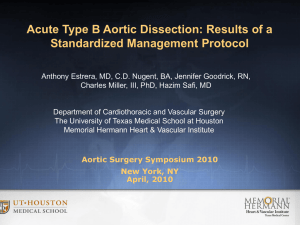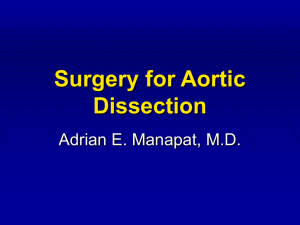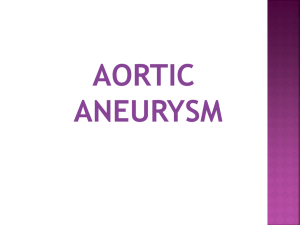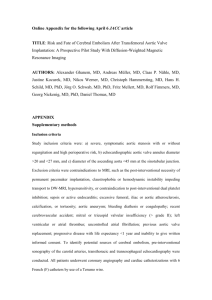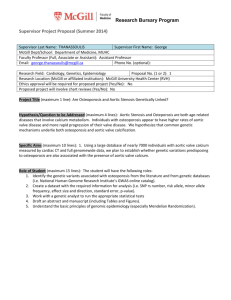Case Studies in Acute Hypertension
advertisement
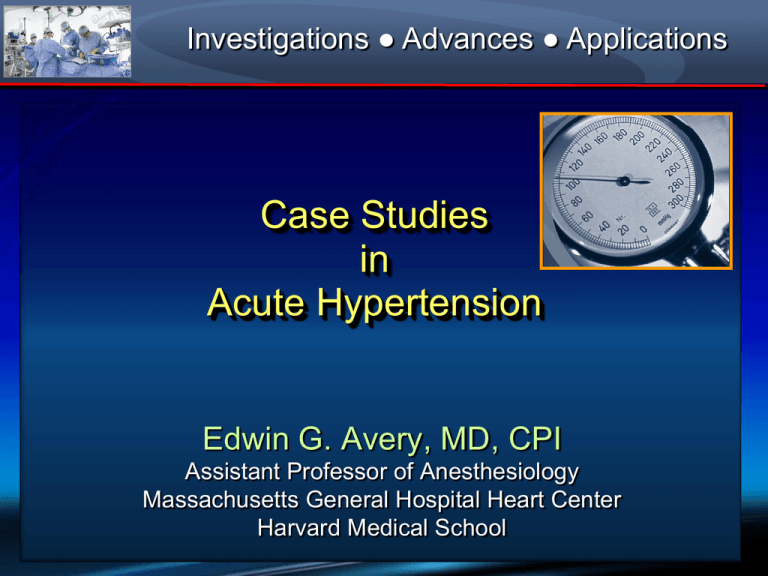
Investigations ● Advances ● Applications Case Studies in Acute Hypertension Edwin G. Avery, MD, CPI Assistant Professor of Anesthesiology Massachusetts General Hospital Heart Center Harvard Medical School Case Studies of Acute Hypertension Case Study #1 Type A Aortic Dissection www.radpod.org Case Studies of Acute Hypertension Case Study #1 Acknowledgement Thank you to Dr. Michael England for sharing this interesting case Case Study 1: Type A Aortic Dissection 44-year-old female presents for surgical correction of a Type A dissection ► HPI: presented to ED complaining of sudden onset of severe chest pain and shortness of breath. ► PHM/PSH: obesity ► Allergies: NKDA ► Medications: none ► Fam Hx: noncontributory ► ROS: unremarkable www.edpma.com Case Study 1: Type A Aortic Dissection ► General: anxious, grossly obese. ► Ht: 62 inches Wt: 102 kg ► VS: 141/45 (R=L); HR 80’s reg; Resp 18; SpO2 96% RA ► Neuro: alert & oriented x3; no gross deficits ► Pulmonary: B/L rales ► Cardiac: S1S2 reg, grade IV syst. murmur ► Extrem: 2+ palpable B/L UE & LE; no edema turbosquid.com Case Study 1: Type A Aortic Dissection Chem: Heme: 141 112 4.0 24 20 1.2 < 110 10 ECG: no ischemic changes CT: TEE: > 12.3 39 < 250 LFTs WNL Coags WNL Case Study 1: Type A Aortic Dissection Diagnosis Type A Aortic Dissection w/severe aortic insufficiency Management ► Immediate β-blockade www.radiologyassistant.nl ► Control SBP with IV antihypertensive to prevent aortic rupture & further extension of dissection ► Proceed to the OR for immediate surgical correction (ascending aortic replacement, +/- AVR) Case Study 1: Type A Aortic Dissection Management ► β-blockade: reduces dP/dt ► IV antihypertensive: reduces shear forces on the weakened aortic wall ► Surgical correction: reduces observed Type A dissection mortality (~↑2% per hour). Uncorrected in-hospital mortality (58%) vs. surgically corrected (27.4%)1. Hagan et al. Jama 2000;283:897 www.radiologyassistant.nl Case Study 1: Type A Aortic Dissection In the OR Case Study 1: Type A Aortic Dissection In the OR Time (HH:MM) SBP Values (mm Hg) v. Time :5 5 10 :4 5 10 :3 5 10 :2 5 10 :1 5 10 :0 5 10 9: 55 9: 45 9: 35 9: 25 9: 15 9: 05 8: 55 180 160 140 120 100 80 60 40 20 0 8: 45 SBP (mm Hg) SBP Values (mm Hg) v. Time Case Study 1: Type A Aortic Dissection In the OR CPB Time (HH:MM) SBP Values (mm Hg) v. Time :5 5 10 :4 5 10 :3 5 10 :2 5 10 :1 5 10 :0 5 10 9: 55 9: 45 9: 35 9: 25 Incision 9: 15 9: 05 Induction 8: 55 180 160 140 120 100 80 60 40 20 0 8: 45 SBP (mm Hg) SBP Values (mm Hg) v. Time Case Study 1: Type A Aortic Dissection In the OR – “The Zone” SBP Values (mm Hg) v. Time Induction Incision 120 Time (HH:MM) :5 5 10 :4 5 10 :3 5 10 :2 5 10 :1 5 10 :0 5 10 9: 55 9: 45 9: 35 9: 25 9: 15 9: 05 95 8: 55 8: 45 180 160 140 120 100 80 60 40 20 0 CPB Case Study 1: Type A Aortic Dissection In the OR – the drugs NTG SBP Values (mm Hg) v.nitroglycerin Time SNP sodium nitroprusside Incision CLV clevidipine NTG SNP Time (HH:MM) :5 5 10 :4 5 10 :3 5 10 :2 5 10 :1 5 10 :0 5 10 9: 55 9: 45 9: 35 9: 25 9: 15 9: 05 CLV 8: 55 8: 45 180 160 140 120 100 80 60 40 20 0 Induction CPB Case Study 1: Type A Aortic Dissection In the OR – the drugs NTG SBP Values (mm Hg) v.nitroglycerin Time SNP sodium nitroprusside Incision CLV clevidipine NTG SNP Clevidipine dose adjustment Time (HH:MM)(mg/hr) :5 5 10 :4 5 10 :3 5 10 :2 5 10 :1 5 10 10 :0 5 8 9: 55 6 9: 45 4 9: 35 2 9: 25 0 9: 15 10 9: 05 CLV 8: 55 8: 45 180 160 140 120 100 80 60 40 20 0 Induction CPB Case Study 1: Type A Aortic Dissection Summary The ultra-short acting dihydropyridine calcium channel blocker, clevidipine, can be used to safely and effectively manage the acute hypertension that accompanies one of the most morbid and potentially mortal disorders of the cardiovascular system. Case Studies of Acute Hypertension Case Study #2 Acute Coronary Syndrome http://library.med.utah.edu Case Studies of Acute Hypertension Case Study #2 Acknowledgement Thank you to Dr. Charles Pollack at the University of Pennsylvania for sharing this interesting case Case Study #2: Acute Coronary Syndrome ►58 y/o male presents to ED with chest pain of acute onset radiating to left jaw and shoulder, accompanied by SOB ►Triage vital signs were pulse 92/min, resp 24/min, and BP 212/126 mm Hg ►PMH included known CAD, CHF, and hyperlipidemia ►ECG performed in Triage http://mykentuckyheart.com Case Study #2: Acute Coronary Syndrome Acute Anterior STE Myocardial Infarction Case Study #2: Acute Coronary Syndrome ► Physical examination: symmetrical bounding pulses, diaphoresis, and rales in both lung bases ► Management: ASA 325 mg Clopidogrel 600 mg Unfractionated heparin by IV infusion Nitroglycerin by IV infusion Beta-blockers are held because of concern over heart failure www.etopiamedia.net ► Prior to cath lab transfer: recheck BP is 196/118; and patient is diagnosed with STEMI + Hypertensive Emergency Case Study #2: Acute Coronary Syndrome Hemodynamic Control Blood Pressure vs. Time & Heart Rate Blood Pressure (mmHg) 225 170 175 SBP DBP 160 125 HR 75 0 2 4 6 8 10 Time (minutes) 12 14 16 Case Study #2: Acute Coronary Syndrome Hemodynamic Control 225 196 192 188 176 175 168 166 162 162 125 75 0 2 4 6 8 10 Time (minutes) 12 14 16 12 10 8 6 4 2 0 Clevidipine (mg/hr) Blood Pressure vs. Time & Heart Rate SB DB HR Case Study #2: Acute Coronary Syndrome Summary Clevidipine can be used safely and effectively to care for a patient with an acute coronary syndrome using a peripheral IV and a blood pressure cuff. There was no evidence of coronary steal or worsening of this patient’s chest pain. Target BP control was obtained in less than 10 minutes. Case Studies of Acute Hypertension Case Study #3 Aortic Valve Replacement Case Study 3: Aortic Valve Replacement 78-year-old male presents for aortic valve replacement ► HPI: presented with symptoms of shortness of breath and DOE. ► PHM/PSH: AS, MI, CAD (stents x2), HTN (brittle), Chol, TIAs secondary to spontaneous cholesterol emboli ► Allergies: NKDA ► Medications: metoprolol ► Fam Hx: noncontributory ► ROS: as per HPI o/w unremarkable Case Study 3: Aortic Valve Replacement ► General: fatigued appearing ► Ht: 72 inches Wt: 90 kg ► VS: 128/62 (R=L); HR 60’s reg; Resp 18; SpO2 98% RA ► Neuro: alert & oriented x3; no gross deficits ► Pulmonary: CTA bilaterally ► Cardiac: S1S2 reg, grade IV syst. murmur ► Extrem: 2+ palpable B/L UE & LE; no edema Case Study 3: Aortic Valve Replacement Chem: Heme: 139 103 4.5 24 25 1.3 < 91 ECG: no ischemic changes TEE: Aortic stenosis (AVA 0.7 cm2), gradient (P 51/M 32 mmHg w/CI 2.9 L/min/m2) 14.1 > 41.2 < 6.8 172 LFTs WNL Coags WNL Case Study 3: Aortic Valve Replacement Diagnosis Severe Aortic Stenosis with left ventricular hypertrophy Management ► Surgical aortic valve replacement with a bioprosthesis ► Control heart rate, maintain NSR, manage SBP with an IV antihypertensive to prevent LV wall stress and MVO2, avoid hypotensive overshoots Case Study 3: Aortic Valve Replacement In the OR Case Study 3: Aortic Valve Replacement In the OR 250 200 150 SBP DBP 100 50 0 Heart Rate Case Study 3: Aortic Valve Replacement In the OR - The Zone Induction 250 Intubation Incision 200 CPB F F 150 SBP DBP 100 50 Heart Rate 2 4 8 16 2 0 2 4 0 Clevidipine (mg/hr) F- Fentanyl bolus 0 Case Study 3: Aortic Valve Replacement Summary Clevidipine can be used safely and effectively to provide hemodynamic support for patients with complex cardiovascular disease profiles (i.e. need to strictly ovoid overshoot hypotension [AS] & reflex tachycardia [AS, LVH, CAD]). Target BP control was expeditiously obtained and maintained in this patient.
